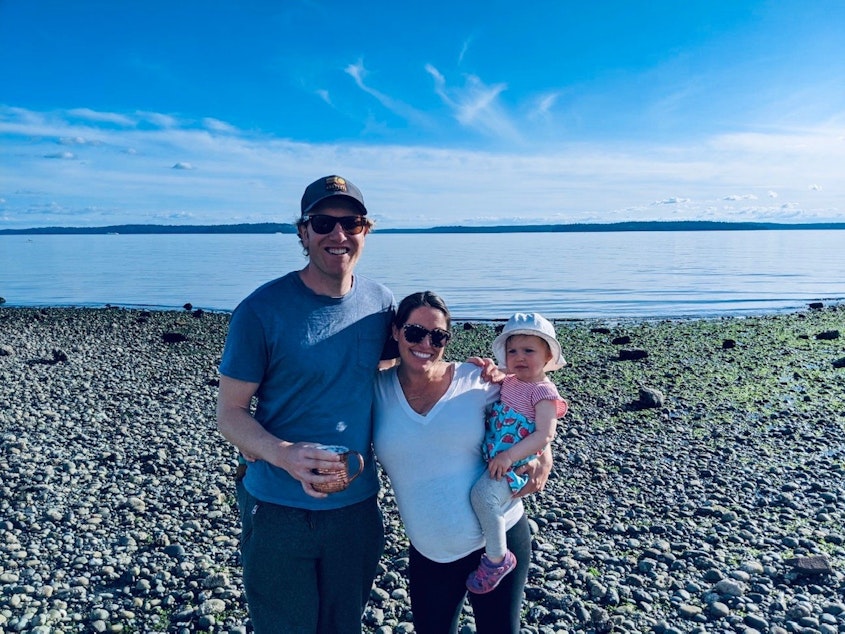West Seattle residents feel like castaways. Metro wants to rescue them

West Seattle residents are feeling isolated, with their main bridge out of commission.
At a time when people are avoiding buses like the plague, King County Metro hopes to show its worth by filling West Seattle's critical need.
Here’s what it’s like to live in West Seattle with the bridge blocked off:
“Like you were all of a sudden told you were going to live on an island that you didn’t sign up to live on, with no good way of getting off,” said Vanessa Dunleavy, a nurse who commutes to Swedish on First Hill. “I think I cried three times the first week that this happened.”
West Seattle is a peninsula. But that word misses what it feels like there, now. The lyrics to the Gilligan's Island theme fit better:
"So this is a tale about castaways, they’re here for a long long time. They’ll have to make the best of things, it’s an uphill climb."
Speaking of uphill climbs, Vanessa Dunleavy's afternoon commute time just tripled.
“Thinking about the time away from my family ... I already work long shifts, so to be away an extra hour and a half today with this commute ... it’s a lot to think about, it’s tough,” she said.
It's so tough, that West Seattle resident Archis Gore has started looking to move out of his Alki beach apartment. It’s too hard now to get to his cybersecurity job in Bellevue.
“It’s very uncomfortable," he said. "The problem is, when I have prior notice, I can go to the office ... with 90 minutes, two hours, whatever."
Gore's expectations have fallen so much, he said he'd be fine with accepting the loss in productivity, were that all. But it goes on:
"If someone wanted to meet me in say, half an hour, I just can’t. I have to give up a customer or a client. I have to give up revenue.”

Both of these commuters say there is something that would help: A bus service that could take them quickly and reliably all the way to their jobs. Neither rely on buses today, but both say they wouldn't rule out a bus service that truly serves their commute.
Metro buses have never been more needed. But this need comes at a time when people are avoiding buses like the plague, literally, due to the pandemic.
That's what makes solving this problem for West Seattle so appealing to King County Metro. Bill Bryant, who's heading a task force at Metro on the West Seattle problem, put it this way:
“A lot of us are looking at the West Seattle situation as one of the limited number of clear opportunities to get our riders back in the system, once the pandemic starts to appear in the rearview mirror.”

Bryant is the managing director of service development at Metro, and his task force is basically a bunch of planners and engineers working from home with cats in their laps. They're trying to think through every hardship stemming from the bridge closure.
“We’re preparing as if it could be indefinite. We want to be ready for any contingency,” Bryant said.
One problem is how few passengers buses can hold now. A short bus normally carries 35 people; a longer bus carries 58.
But with social distancing in effect, “Those buses can now carry only 12 or 18 customers, respectively,” Bryant said.
Then, there’s the uncertainty about which roads will remain open. Metro is planning for two key scenarios, both of which have many potential variations.
Scenario number one: If the Spokane Street Swing Bridge, which runs sort of below and next to the West Seattle Bridge, is still open, Metro could dramatically increase the number of buses there.
Imagine a convoy of mostly empty but frequent buses. That could tempt commuters out of their cars. “With the transit priority that Metro has on the low bridge, we will clearly be the best choice for many trips.”
But that opportunity comes at the expense of other routes, Bryant said. Extra buses aren't free.
Scenario number two, however, is worse.
In that scenario, the lower bridge is closed. That could happen if the upper bridge collapses on top of it. That would force most of West Seattle’s buses to make their way three and four miles south to the next two bridges, closer to the South Park neighborhood. That is a very long detour for some.
And then, those buses would have to compete with cars to cross. “What is traffic going to look like on those bridges?" Bryant asked. "How can we get those buses through?”
With bus trips extended by that congestion, Metro might settle for getting people halfway to their destination, dropping them off at a light rail station instead.
That indirect commute won't work for everyone. That's why Metro’s looking at getting a second or even a third passenger ferry to run off Alki Beach (SeaCrest Dock). If the lower bridge is closed, some bus routes would be reconfigured to feed more passengers to those water taxis.
Metro planners are thinking through these scenarios because of the isolation that West Seattle residents feel now. The sense of living on an island could give Metro the chance to play the hero, like the helicopter that rescued the castaways from Gilligan’s island.

